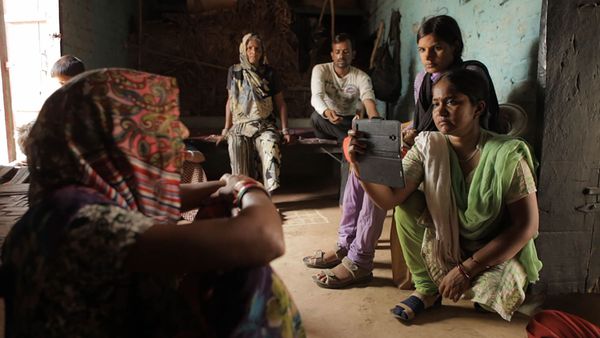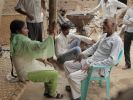Eye For Film >> Movies >> Writing With Fire (2021) Film Review
Writing With Fire
Reviewed by: Jeremy Mathews

It’s tricky to make a documentary that exposes harsh, sad truths, while also providing a beacon of hope. Many an issue doc has spent 90 percent of its runtime detailing how we’re all doomed, only to try rally the audience with an inspiring coda explaining what ordinary people can do to turn things around. But Writing with Fire deftly infuses hope and inspiration into what could rightfully have been a wholly dire depiction of India’s most trodden-upon population.
Directors Rintu Thomas and Sushmit Ghosh’s film achieves this feat with a subject that doubles as a narrative device: the leadership and staff of Khabar Lahariya, an Indian newspaper run entirely by women from the Dalit (“untouchable”) caste. Because the subjects are journalists, the filmmakers are able to use their reporting as a jumping-off point to create a broader portrait of the region. We explore what happens when a village can’t connect to an electrical grid or when essential roads fall into disrepair, or when farms don’t have irrigation. Khabar Lahariya’s reporting leads to greater public awareness of these issues and, in turn, government response.

But the newsroom stories are just as compelling as those they’re covering. The struggles of the staff alone offer a big window into the Dalits’ lives. On one hand, the editors are schooling staff who haven’t had access to elite journalism education, and are largely learning the trade as they go. On the other, they don’t have access to the resources that we take for granted. The movie begins as Khabar Lahariya decides to join the push to digital in order to survive. They give their reporters cell phones with cameras that become their most valuable tools. But even with phones in their possession, some of the reporters don’t have access to electricity to charge them.
The reporters build up impressive resumés in the face of an oppressive culture and disapproving family members. Meera, who was a wife at age 14 and a mother not long after, leads an army of ambitious and hungry reporters, yet still faces criticism from her husband for working on things that aren’t part of family life.
One of Meera’s reporters, Shyamkali, comes to journalism without much educational or training, but is such a quick learner that she makes it seem easy to gain skills others work for well into their careers. She shows her ability in a race that she began 40 yards behind the starting line.
The accounts of the publication’s success can seem a little superficial at times. For example, Writing With Fire often shows a story’s value based on the social media engagement it generates, but never goes into depth about how its leaders feel about the new shift to digital, or what it means to Khabar Lahariya’s finances and ability to publish in the future. It doesn’t ruin the content that’s there, but it does make it feel like certain details stay unexplored.
While there’s not a robust narrative thrust, the brave and ambitious reporters are great subjects, and their reporting offers a window into a rarely seen part of India. The news they report can be quite bleak, but it’s inspiring to get to know these marginalised women as they find success speaking truth to power.
Reviewed on: 08 Jun 2021















